
Making roads safer for wildlife at Parks Canada
We’re all in the driver’s seat to make a difference for wildlife!
Each year, Parks Canada welcomes millions of visitors into the natural habitats of mammals, birds, reptiles, and amphibians. Whether you are visiting or passing through national parks, your time on the road could be putting you and wildlife at risk of injury or death.
Parks Canada works with many partners across the country on solutions to make roads safer for wildlife—and people—in protected areas.
Animals on the move
Many species must travel across roads and beyond park boundaries to find shelter, food and water, mates, and to raise their young. Their unrestricted movements also help promote gene flow across the population. This can make wildlife more resistant to disease and other stressors.
Likewise, roads and railways in Canada allow us to explore and connect us with family and friends. They also help move vital food and supplies across the country.
Yet roads divide the land, creating scattered patches of habitats. They negatively impact ecological connectivity by impeding the natural movements of wildlife across the land. This makes it harder for wildlife to move freely and safely in their habitat.


Helping animals cross the road
Parks Canada and partners use innovative solutions in national parks to keep visitors and wildlife safe. Our efforts also help reconnect landscapes that have been fragmented by roads.
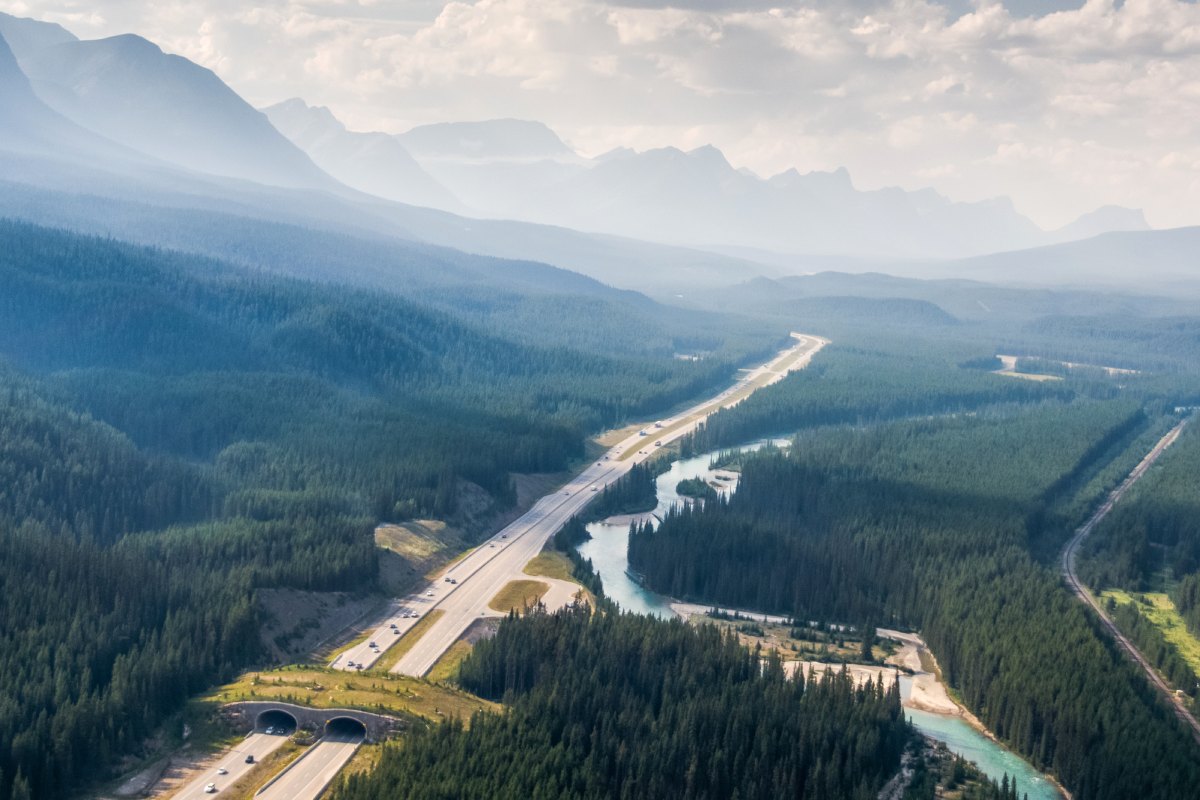
We build crossings that help wildlife move between patches of habitat, without the risk of being hit by a vehicle.
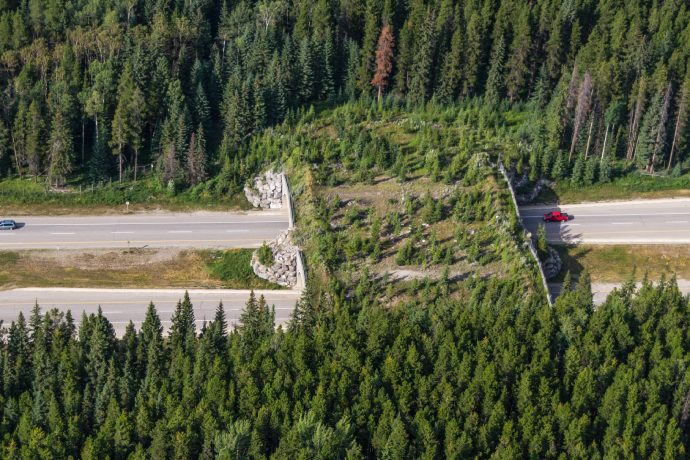


We have proof that these efforts are reducing the risk of wildlife collisions, and restoring ecological connectivity. Some of the wildlife protected by these crossing structures include:
- large and small mammals, such as the Canada Lynx and American Marten
- snakes, salamanders, frogs, and turtles including species at risk
Photos taken by wildlife remote cameras
Select images to enlarge
We use a suite of different tools to reduce the impacts of roads on wildlife in national parks. This helps protect many species—from Canada Lynx in Terra Nova, to American Marten in Forillon, to Wood Bison in Wood Buffalo.
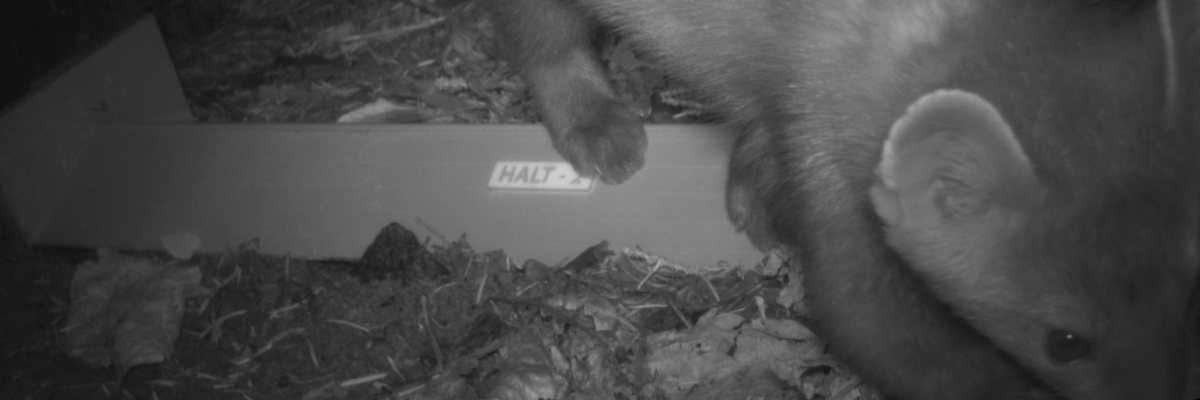
Paving the way
Parks Canada staff, including teams from Banff National Park and Highway Engineering Services, are leaders in helping many species cross roads safely. Conservation staff plan and monitor wildlife crossing structures. While the asset team designs and constructs the infrastructure. These efforts help keep wildlife—and people—safe during travels on the road.
.jpg)
The Trans-Canada Highway spans the Rocky Mountains. By the late 1970s, traffic in the Bow Valley became too heavy for the two-lane highway. Close to 100 large animals were dying every year on this busy stretch of road. In the early 1980’s, Parks Canada began work with transportation partners to twin the highway. They used this opportunity to explore new ways to reduce wildlife collisions and reconnect landscapes.
Since then, Parks Canada and partners have maintained the longest road-ecology study in the world. Their groundbreaking use of wildlife crossings has proven successful in reducing wildlife deaths in Banff, Yoho, and Kootenay national parks. This has been especially true for large mammals.

.jpg)
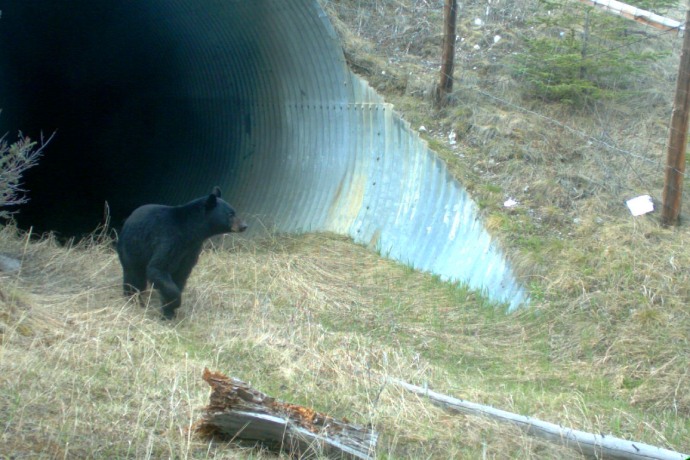
The 49 crossing structures (42 underpasses and 7 overpasses) reduced wildlife collisions by more than 80%, and by over 96% for elk and deer alone. Inspired by this success, wildlife crossings are now built and advocated for across the country to protect species and drivers.
Watch the asset team build a wildlife crossing in Kootenay National Park in British Columbia:
Text transcript
[Music begins. "March of Time 3" by Tim Garland, Geoffery Keezer, and Joseph Locke.]
Kootenay National Park: Helping wildlife cross the road
More than 300 white-tailed deer and many other animals died on this highway between 2003 and 2012. One section was 4 times as deadly as the average.
This underpass and eight others under 15 kilometres of fenced highway are changing that.
The Wildlife Crossing Project www.parkscanada.gc.ca/hwy93s
Kootenay National Park: Helping wildlife cross the road
First of its kind
Smaller animals like amphibians, snakes and turtles—many of which are species at-risk—use special tunnels called eco-passages to safely cross roads in national parks.
Parks Canada is working to protect the Long-toed Salamander at Waterton Lakes National Park in Alberta, where the species is of Special Concern. Each year, some of the salamanders must cross the road to reach the lake where they breed. In the late 1990s, almost half of Long-toed Salamanders observed there were killed during this annual migration.
Today, the salamanders make it across the road safely thanks to the eco-passages installed by Parks Canada and supported by volunteers. The salamander road crossings in Waterton Lakes were the first of their kind in Parks Canada places. This work has since inspired other national parks and organizations to follow suit.
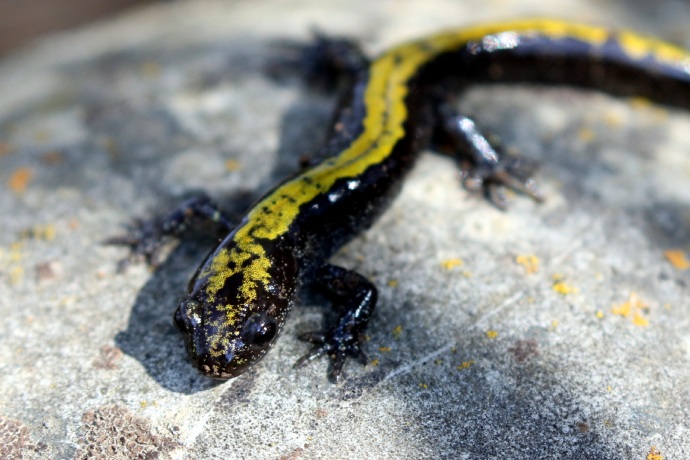
.jpg)
Watch how Parks Canada uses eco-passages and exclusion fencing to help save the Long-toed Salamander and other amphibians from road mortality:
Text transcript
Parks Canada Beaver Logo
A dark green illustrated map of Canada showing Waterton Lakes National Park appears, then zooms into a roadway inside the park with Long-toed Salamanders crawling across the road.
The date “1994” is indicated in the top left corner. A label in the bottom right corner indicates that the roadway mortality rate of Long-toed Salamanders crossing the road in 1994 is 10%.
Animated cars begin driving along the road overtop of the salamanders. A red X appears over the salamanders, representing their death.
As the year in the top left corner increases, the number of cars driving on the road also increases. The roadway mortality rate also increases to 40% in 2001.
The date increases to 2008 and the frame zooms out to reveal a larger section of the roadway. Four amphibian underpasses appear along the roadway. A section of fencing spans either side of the road.
The frame zooms in to reveal that the fencing limits access to the roadway and directs salamanders to the amphibian underpasses.
The salamanders cross under the roadway safely while cars continue to pass over top.
The year increases to 2009 and the roadway mortality rate has decreased to 0.6%.
Text appears above an illustrated salamander that says: “Salamanders roadway mortality decreased from 44% to 0.6%
Government of Canada logo
Give me a brake
Parks Canada is working to educate drivers and promote responsible driving to reduce wildlife mortality on roads. Southern Ontario has the highest density of roads in Canada. Road mortality is the biggest threat to turtles in this region, many of which are species-at-risk.
.jpg)
Conservation scientists at Bruce Peninsula National Park and Fathom Five National Marine Park built eco-passages and exclusion fencing to help turtles cross busy roads safely.


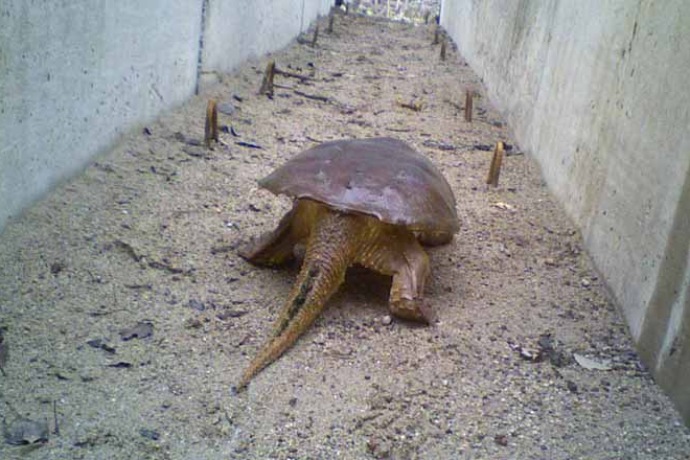
The “Give me a brake” campaign urges drivers to safely slow down and stop for turtles at Rouge National Urban Park in Ontario.

The road to recover turtle populations isn’t easy—but it is possible
Text transcript
Parks Canada logo
[upbeat music throughout] [narrator] From the day they're born,Turtle hatchling emerges from its nest for the first time, explores land and water.
turtles are on the move. Turtles travel across a range of different habitatsAerial view of a natural setting with turtles moving around; roads are developed.
to mate, nest, and find food and water. When roads are developed in an area, it can cause habitat fragmentation. This means that turtles and other animalsTurtle crossing road while a car is rapidly approaching.
must cross over roads to get from one habitat to another. Many animals are hit and killed by cars while trying to move between habitats, which is known as road mortality. Roads are one of the leading causes of declineRoads wrapping around a view of earth from space.
of reptile and amphibian populations worldwide. Today, seven out of Ontario's eight turtle speciesPie charts demonstrating the number of at risk turtles and snake species in Ontario.
and 10 out of Ontario's 16 snake species are classified as 'at risk'. The Bruce Peninsula is a thriving natural areaAerial view of the Bruce Peninsula.
that extends between Lake Huron and Georgian Bay. Bruce Peninsula National Park protects the largest section of green space in southern Ontario, and is rich in biodiversity. The park is home to 26 different speciesSymbols of frogs, snakes, and turtles pop up within the park area.
of reptiles and amphibians! At our park, we're taking action to protect our reptiles and amphibiansView of park sign with turtle walking underneath.
through the On the Road to Recovery project. This project includes a special focus on species at risk, such as the Common snapping turtle, Massasauga rattlesnake, Eastern ribbonsnake,Animations of common snapping turtle, Massassauga rattlesnake, eastern ribbonsnake, and eastern milksnake.
and Eastern milksnake. We're making our roads safer for wildlife by installing Eco-passages and Eco-fencingPark staff installing an eco-passage.
at road mortality hotspot locations. The Eco-fencing acts as a barrier, guiding turtles, snakes, frogs, and other small animals towards the Eco-passages,Turtle using an eco-passage.
allowing them to cross underneath roads safely. We're also creating artificial turtle nesting sitesAdult turtle nesting on an artificial nesting mound.
near known turtle habitats. This way, female turtles can lay eggs without even crossing the road! You can help protect reptiles and amphibians too! Watch for wildlife on the road, especially when driving through natural spaces.Turtle crossing in front of a car.
If you see a turtle on the road, pull your car over where it's safe, and help the turtle across in the direction it was going. If it's a snapping turtle,Driver pulls over, helps turtle across the road using a shovel.
you can use a stick, shovel or paddle to move it across. Don't forget to record your turtle sighting and location on the Ontario Reptile and Amphibian Atlas app.Person records turtle sighting on their phone; turtle swims in the lake.
You can also use this app to report snake, frog, or salamander sightings. Get involved! Bruce Peninsula National ParkPerson takes nest cage off of turtle mound, records data on clipboard.
has a Citizen Science volunteer program to help monitor and protect turtles! You could help contribute important data on turtle activity, and give hatchling turtles a better chance at survival. Go to parkscanada.gc.ca/ bruce-recoveryView of Parks Canada webpage.
for more information, and help us make the world a little safer for turtles...Turtle crosses underneath road in an eco-passage; car zooms overtop.
[music ends]On the Road to Recovery logo.
Parks Canada logo.
© Her Majesty the Queen in Right of Canada, represented by Parks Canada, 2018.
Canada wordmark.
Caught on camera
Want to see who is crossing the road safely? Trail cams set up by Parks Canada conservation staff capture wildlife crossings in action, giving us a clearer picture of the species using these crossings:
- Watch some of the species using an underpass at Bruce Peninsula National Park
- Watch 5 years of trail cam footage of wildlife crossings in Banff National Park (Warning: This video contains flashing images)



Fatal attraction
Craving a good snack on a road trip? You are not alone. Animals are attracted to human food, garbage, salt, and vegetation on the roadside. Some are even attracted to the heat radiating from summer roads. As animals become more familiar and comfortable with roads, there is more risk of conflict, injury—or death—for both wildlife and people.


Across the country, Parks Canada is working with transportation partners to help steer wildlife away from roads. We take many actions to achieve this, like managing roadside vegetation and installing salt licks that deter wildlife from approaching the road. You can do your part by disposing of all garbage and food waste in designated bins.
Don’t make the roadside an attractive place for wildlife!
.jpg)
How you can help save wildlife while on the road
Parks Canada is working hard to make roads safer for wildlife and people across the country. Yet we can't protect wildlife on roads alone! You also have an important role to play in keeping wildlife and people safe while in national parks:
- Respect speed limits—speeding kills! That’s because speeding:
- reduces reaction time for both drivers and wildlife
- reduces ability to maneuver vehicle quickly and effectively to avoid a collision
- increases the force of an impact, making it more likely to cause fatal injuries
- lessens your chances of spotting wildlife and taking evasive action
- requires longer distances to brake for wildlife
- Don’t create a hazard by stopping to take photos of roadside wildlife
- Be alert and anticipate seeing wildlife on the road, even in areas with wildlife fencing
- Watch for road signs that indicate wildlife crossings
- Look out for speed feedback signs that alert you of your speed
- Slow down for speed bumps in sensitive areas


These measures are effective, but only with your help… Thank you for slowing down for wildlife when driving in protected areas—their life depends on you.

Learn more
- Wood Bison on roads at Wood Buffalo National Park in Alberta and Northwest Territories
- Help keep mountain goats off the road in Mount Revelstoke and Glacier National Park in British Columbia with official Parks Canada merch
- Snakes on the road at Grasslands National Park in Saskatchewan
- Working together for ecological connectivity at La Mauricie National Park in Quebec
- Date modified :



.jpg)



.jpg)
.jpg)